Difference between revisions of "Thulite"
Jump to navigation
Jump to search
| Line 8: | Line 8: | ||
zoisite; rosaline | zoisite; rosaline | ||
== Physical and Chemical Properties == | == Physical and Chemical Properties == | ||
| − | + | * Cleavage = perfect in one direction | |
* Luster = vitreous | * Luster = vitreous | ||
* Fracture = conchoidal to uneven | * Fracture = conchoidal to uneven | ||
| + | * Streak = white or gray | ||
* Fluorescence = inert | * Fluorescence = inert | ||
* Pleochroism = present; and possibly dichroism or trichroism depending on color | * Pleochroism = present; and possibly dichroism or trichroism depending on color | ||
| Line 20: | Line 21: | ||
|- | |- | ||
! scope="row"| Density | ! scope="row"| Density | ||
| − | | 3. | + | | 3.1-3.4 g/ml |
|- | |- | ||
! scope="row"| Refractive index | ! scope="row"| Refractive index | ||
Revision as of 12:13, 23 December 2022
Description
A pale to deep pink translucent Zoisite stone in which manganese replaces up to 2 % of the calcium. Thulite was discovered near Telemark, Norway and named for Thule, an old name for Norway. It has been used as a gemstone and often has streaks of gray or white.
Synonyms and Related terms
zoisite; rosaline
Physical and Chemical Properties
- Cleavage = perfect in one direction
- Luster = vitreous
- Fracture = conchoidal to uneven
- Streak = white or gray
- Fluorescence = inert
- Pleochroism = present; and possibly dichroism or trichroism depending on color
| Mohs Hardness | 6.0 - 6.5 |
|---|---|
| Density | 3.1-3.4 g/ml |
| Refractive index | 1.691 - 1.700 |
| Birefringence | 0.006 - 0.018 |
Resources and Citations
- Gem Identification Lab Manual, Gemological Institute of America, 2016.
- Wikipedia Thulite Accessed Dec 2022
- Mineralogy Database: Zoisite
